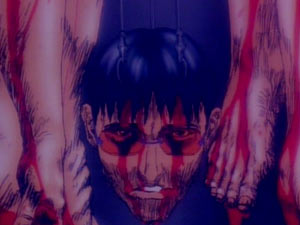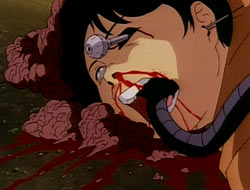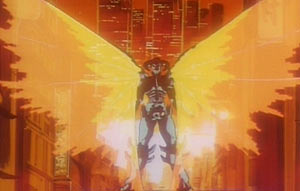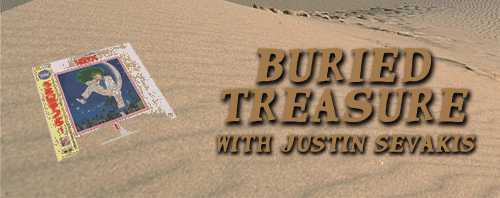Buried Treasure
Genocyber
by Justin Sevakis,
A lot of people hate Genocyber. They usually have good reasons for doing so. It's directed by Kōichi Ōhata, the man responsible for the nearly universally-deriled MD Geist. It's low-budget, schlocky and gory as hell. It's also a fascinating indictment of the human spirit, at once deeply cynical about humanity and sympathetic to the plight of the individual. It's an early hint at what was to come from noted anime screenwriter Noboru "Shou" Aikawa, whose early career was filled with sex and violence anime (including the original Urotsukidoji and Angel Cop), but has since given us such masterpieces as Fullmetal Alchemist and Twelve Kingdoms.
 Genocyber is split into three arcs, best taken as three completely separate shows. The first arc (in one 50-minute episode) is the one that makes an impression. Set in the cold, unfeeling, dirty and crowded city of Hong Kong in the near future, we learn of some rather interesting scientific experiments taking place. These experiments manipulate the spiritual and psychic power from within a person to become useful energy, or a weapon (of course). The experiments, along with many others involving cyborgs, are being carried out in a shadowy Government-funded corporation called the Kuryu Institute, and as the government is finding itself in an increasingly politically stable world, they're starting to wonder what exactly this organization has been up to. The two main test subjects are twin sisters who seem to have both been born missing some basic essence of themselves: there's Diana, who's of sound mind but nearly no useful body (it's since been augmented). Elaine, meanwhile, has extremely strong psychic power but the mind of an animal. Elaine is where the power lies, and Diana, the control. Their father, Dr. Kenneth Reed, is the very scientist toying with their souls.
Genocyber is split into three arcs, best taken as three completely separate shows. The first arc (in one 50-minute episode) is the one that makes an impression. Set in the cold, unfeeling, dirty and crowded city of Hong Kong in the near future, we learn of some rather interesting scientific experiments taking place. These experiments manipulate the spiritual and psychic power from within a person to become useful energy, or a weapon (of course). The experiments, along with many others involving cyborgs, are being carried out in a shadowy Government-funded corporation called the Kuryu Institute, and as the government is finding itself in an increasingly politically stable world, they're starting to wonder what exactly this organization has been up to. The two main test subjects are twin sisters who seem to have both been born missing some basic essence of themselves: there's Diana, who's of sound mind but nearly no useful body (it's since been augmented). Elaine, meanwhile, has extremely strong psychic power but the mind of an animal. Elaine is where the power lies, and Diana, the control. Their father, Dr. Kenneth Reed, is the very scientist toying with their souls.
There is no future for either of the girls. Diana lives a desperate existence as her father's lab rat, and Elaine has escaped and has made friends with a young street urchin (who's routinely abused by the local gang). There's a massive manhunt underway, but Elaine attacks her pursuers psychically, usually implanting nightmarish images in their minds and causing them to self-destruct in the most gruesome way possible. As Diana is dispatched to bring her back, Elaine confesses what they both already know: the Kuryu institute will kill them eventually. But Diana, the cripple, is too resentful of Elaine's freedom for it to matter.
 Some hired guns attempt to bring her back to Kuryu, but kill her in the process, along with her young friend. This starts the ball rolling. Diana realizes just what a tortured life she's lead, and then... the spirit of Elaine comes and fuses with her. And these two people, damaged irrevocably and left for dead by life and society become something greater than their two halves. And this monster they become, this deity of hatred and bitterness, will make everything right. And we get to watch.
Some hired guns attempt to bring her back to Kuryu, but kill her in the process, along with her young friend. This starts the ball rolling. Diana realizes just what a tortured life she's lead, and then... the spirit of Elaine comes and fuses with her. And these two people, damaged irrevocably and left for dead by life and society become something greater than their two halves. And this monster they become, this deity of hatred and bitterness, will make everything right. And we get to watch.
Despite making limited appearances, Genocyber itself steals the show. Designed by Tony Takezaki (who also wrote the manga version), it's intriguingly rendered and terrifying in appearance. Genocyber is the manifestation of human suffering made into a God. It's as if the part of humanity that's incomplete, the deep loneliness that aches for companionship and social contact was left in petri dish to breed and fester. Of course, there's a gushy, organic transformation scene, complete with the ripping of membranes and flesh, like a parasite bursting out of the corpse of its host.
 Genocyber's soundtrack is quite distinctive; despite being 100% electronic and dated by today's standards, its main theme is at once stirring and horrifying. The English dub for the first three episodes was produced by Manga UK, and while I consider myself a fan of their dubs, this one is particularly decent; their practice of punching up their scripts with unnecessary swearing is surprisingly effective here. That isn't to say there aren't occasional unintentionally funny moments, but overall the show is still quite easy to take seriously. The English voice actress for Diana in particular, a woman named Rosemary Elliot (a pseudonym, perhaps) is far better than her Japanese equivalent.
Genocyber's soundtrack is quite distinctive; despite being 100% electronic and dated by today's standards, its main theme is at once stirring and horrifying. The English dub for the first three episodes was produced by Manga UK, and while I consider myself a fan of their dubs, this one is particularly decent; their practice of punching up their scripts with unnecessary swearing is surprisingly effective here. That isn't to say there aren't occasional unintentionally funny moments, but overall the show is still quite easy to take seriously. The English voice actress for Diana in particular, a woman named Rosemary Elliot (a pseudonym, perhaps) is far better than her Japanese equivalent.
Genocyber loses a bit of its intelligence after the first episode. The second two episodes involve the now-complete Genocyber (who is now just Elaine when she's not completely pissed off) on an aircraft carrier, where she's been taken in by a delusional nurse suffering from the loss of her own daughter. Another scientist mucking about with evil things finds the wrath of Genocyber, and it all pretty much ends in continued gleeful death and destruction.
 Unfortunately it all goes to hell in the last two episodes, a plodding and disjointed episode (involving a blind girl, her devoted boyfriend and a cult) made completely unwatchable by a truly odious dub courtesy of Audioworks Producers Group (Manga UK never picked up these episodes). As each arc is completely stand-alone there's no harm in skipping this one, but if you do watch it, watch it subtitled.
Unfortunately it all goes to hell in the last two episodes, a plodding and disjointed episode (involving a blind girl, her devoted boyfriend and a cult) made completely unwatchable by a truly odious dub courtesy of Audioworks Producers Group (Manga UK never picked up these episodes). As each arc is completely stand-alone there's no harm in skipping this one, but if you do watch it, watch it subtitled.
If there's one area where anime has trouble matching up to its live action counterparts, it's in the splatter. Dried paint on acetate can be plenty graphic and gross, but in terms of overall impact, it doesn't even come close to the gushy look of the fake gore used in movies. Genocyber takes a novel approach to this problem by simply cutting in shots of wet clay models. Voila! The glistening ickiness of real gore. Only the first episode takes this unusual step, which is fitting, since it's the only one doing any creative heavy lifting.
Genocyber is also the only piece of filmed entertainment I can even remember that breaks the unwritten rule that you never show a child getting seriously injured or killed. In fact, it takes sadistic glee in being as graphic as possible: the second episode begins with Elaine playing with some island children... and when the military comes for her, the machine guns tear her young friends into pieces. In slow motion. Splattered brains feel different when they're 12 years old.
 I have something of a history with Genocyber. When I was thirteen, I was just discovering anime on the shelves of my local Blockbuster Video. I had persuaded my (fairly strict) parents to ignore the Youth Restricted Viewing sticker. After all, the anime I had seen up to that point wasn't that bad. In fact, some had been outright PG rated. In putting that damned sticker on every single Anime Box regardless of its content, it had lost its meaning.
I have something of a history with Genocyber. When I was thirteen, I was just discovering anime on the shelves of my local Blockbuster Video. I had persuaded my (fairly strict) parents to ignore the Youth Restricted Viewing sticker. After all, the anime I had seen up to that point wasn't that bad. In fact, some had been outright PG rated. In putting that damned sticker on every single Anime Box regardless of its content, it had lost its meaning.
So you can imagine when my Blockbuster started stocking Genocyber Part 1, I grabbed the tape, hungry for some new anime I'd never seen before. My virgin eyes were not ready for it. Shocked and appalled that it was given the same age rating as Project A-ko and all the other mild fare I'd seen at the time (and being way too precocious a kid) I sat down and wrote a nasty letter to Central Park Media. I expressed that I thought CPM had a moral responsibility to educate its viewers as to what they could expect when they bought or rented one of their videos, and took personal issue with the lack of regard for their more sensitive customers (such as myself).
John O'Donnell of CPM was kind enough to write me back ("I suggest you take it back to the store") and included a Project A-ko poster, in what was probably the nicest "shut up kid" I've ever gotten in my life. Had I been John, I probably would have sent me a Genocyber (or Urotsukidoji) poster.
Just the same, I tried watching it again soon after, nearly daring myself. After I was sufficiently desensitized, I found it easy to relate to. It eventually became a part of my life, to the point where I once identified a "Genocyber" ink blot while taking a Rorschach test. (I did not have the presence of mind to tell my psychologist about the series' inner themes, but sometimes I wish I had.)
I would later, of course, spend three and a half years of my life working at CPM side-by-side with John. In the back of my head, I remembered the letter I sent, and was grateful that he didn't remember it... or at least, he didn't until he found it in his files last year (and forwarded it to everyone).
Genocyber is not for everyone. You have to be able to appreciate anger, the sort of nihilism and angst that fills and infects one's soul. It's the anime equivalent of rocking out to Marilyn Manson. If everyone could enjoy it, the would would be even scarier than it already is.
| Obscure-O-Meter™ | |
| A | Abundant. Available anywhere that carries anime. |
| C | Common. In print, and always available online. |
| R1 | US release out of print, still in stock most places. |
| R2 | US release out of print, not easy to find. |
| R3 | Import only, but it has English on it. |
| R4 | Import only. Fansubs commonly available. |
| R5 | Import only, and out of print. Fansubs might be out there. |
| R6 | Import long out of print. No fansubs are known to exist. |
| R7 | Very rare. Limited import release or aired on TV with no video release. No fansubs known to exist. |
| R8 | Never been on the market. Almost impossible to obtain. |
| Adapted from Soviet-Awards.com. | |
Where to get it:
All five Genocyber episodes and their respective dubs were put out on DVD by CPM. Unfortunately, it's an early release mastered from PAL-converted VHS dub masters, so its quality is not fantastic by today's standards. That's not to say it's a bad disc; in fact, the animation is rough enough that the slight video problems don't really detract much from the viewing experience. It's now been out of print for quite a while, but there are copies floating around online. There doesn't seem to be any other DVD in existence.
Screenshots ©1993 ARTMIC/Plex. All rights reserved.
discuss this in the forum (51 posts) |
